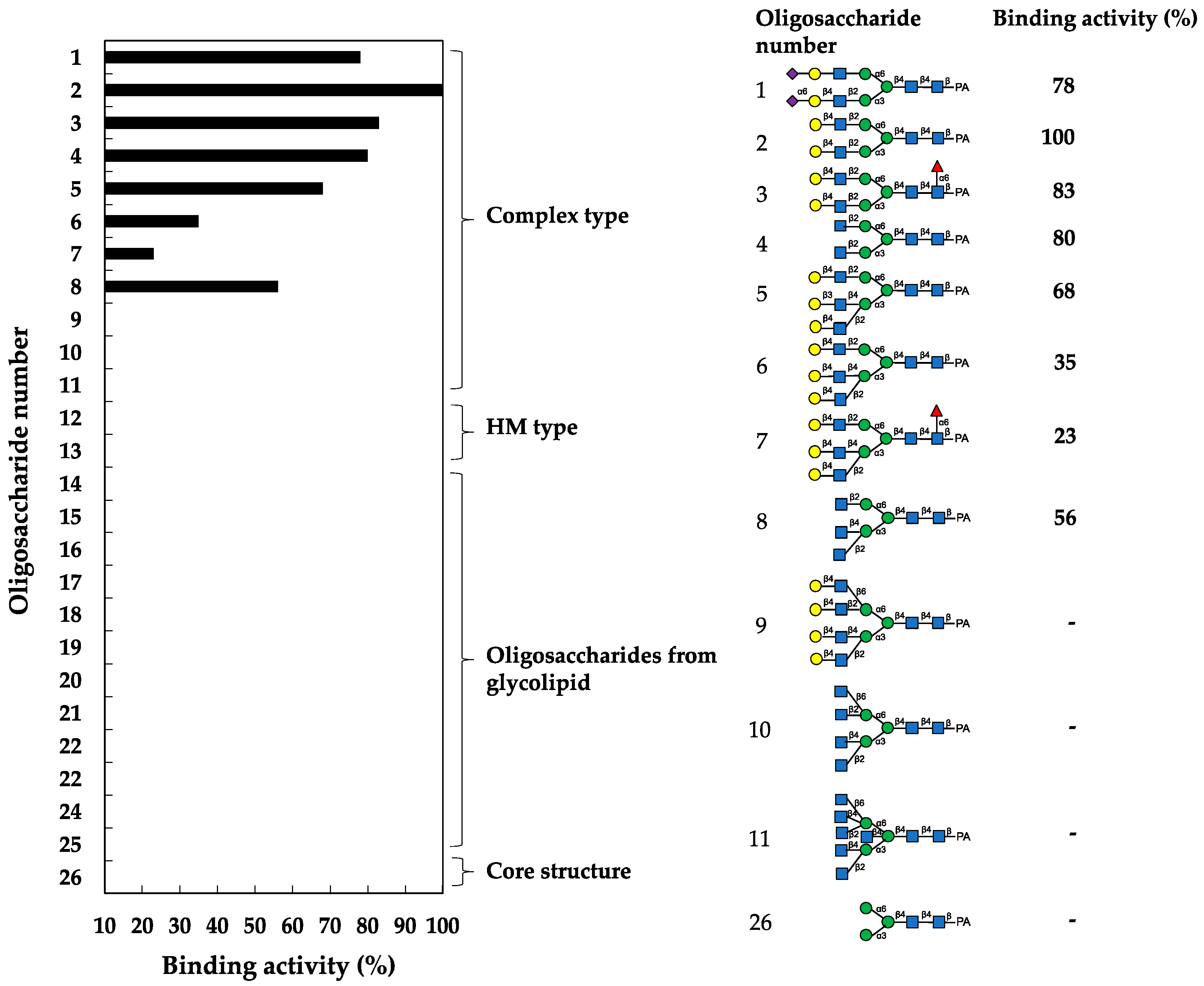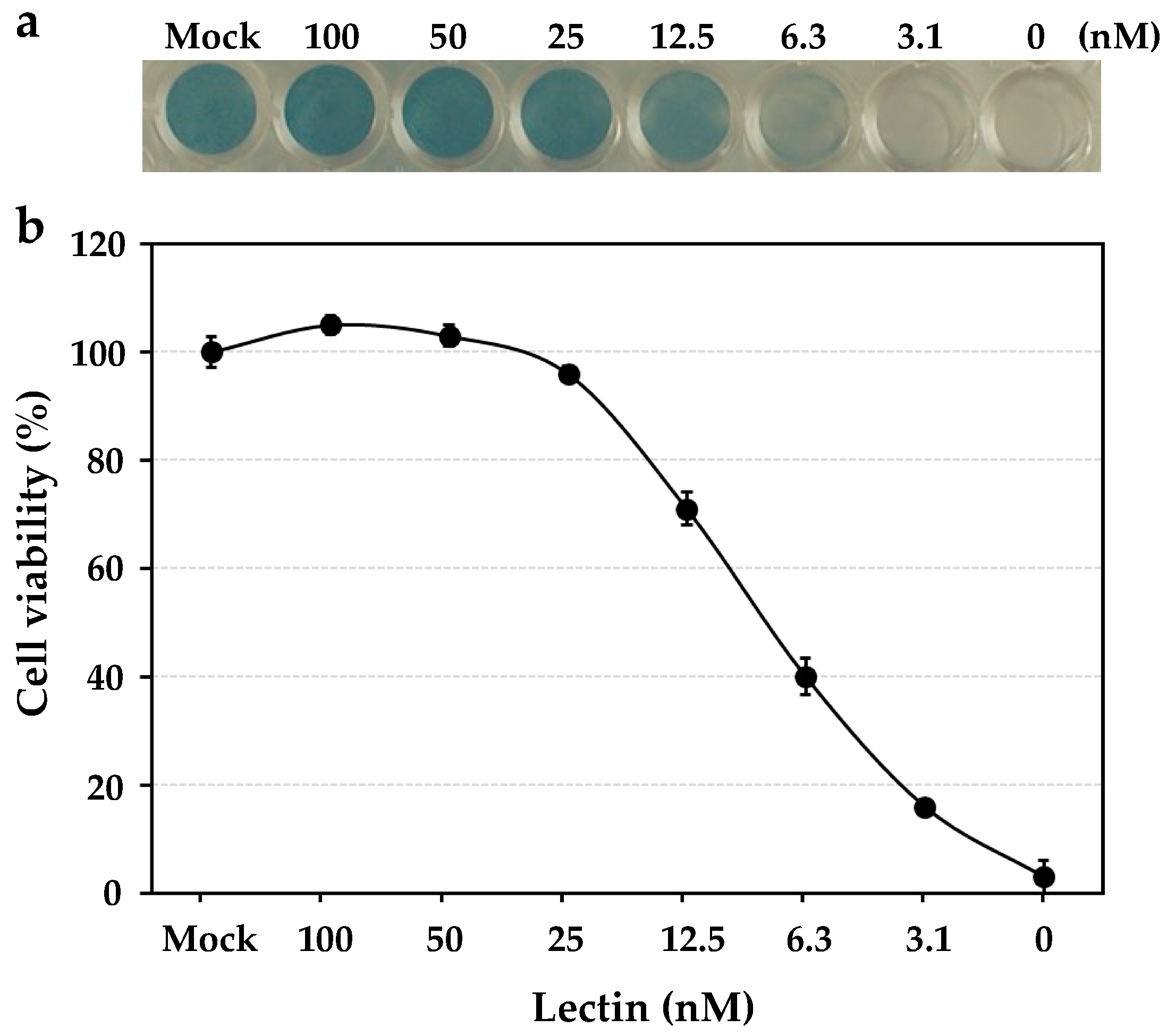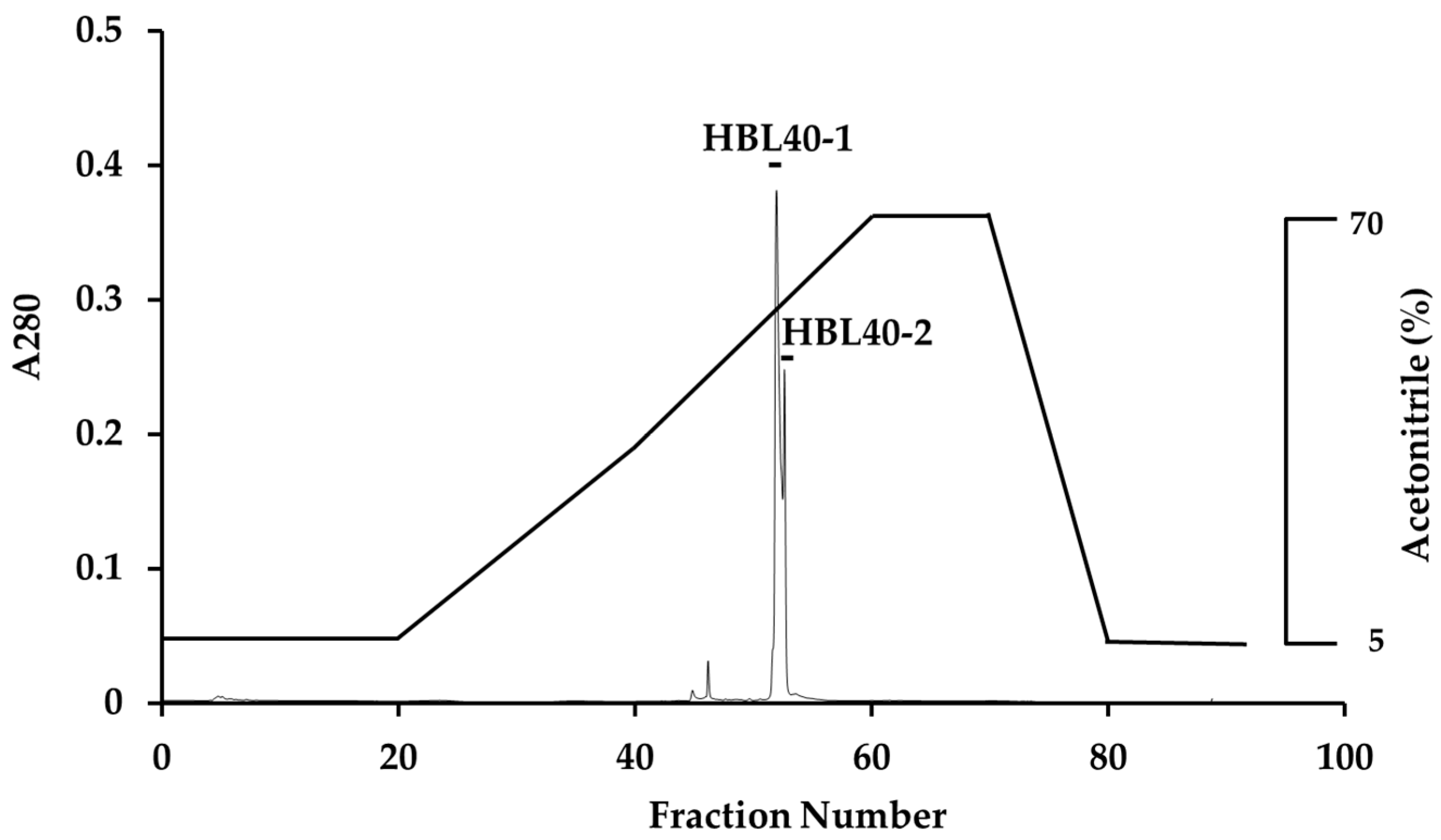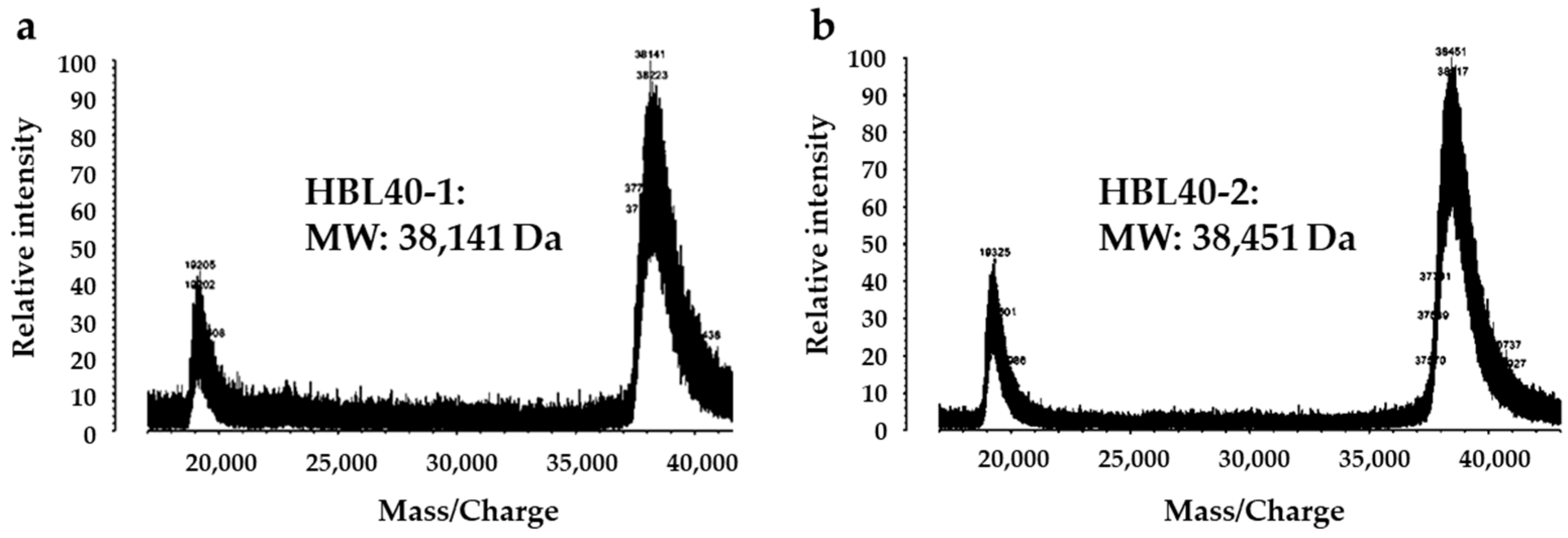A Complex-Type N-Glycan-Specific Lectin Isolated from Green Alga Halimeda borneensis Exhibits Potent Anti-Influenza Virus Activity
Abstract
:1. Introduction
2. Results
2.1. Purification of Complex-Type N-glycan-Specific Lectin HBL40
2.2. Hemagglutination-Inhibition Test by Sugars and Glycoporteins
2.3. Binding Specificity to Oligosaccharides
2.4. Inhibition of Virus Infection by HBL40
2.5. Interaction between HBL40 and Envelope Hemagglutinin of Influenza Virus
2.6. Molecular Structure of HBL40
3. Discussion
4. Materials and Methods
4.1. Materials
4.2. Purification of Lectin HBL40 from H. borneensis
4.3. Determination of Protein Contents
4.4. Sodium Dodecyl Sulfate–Polyacrylamide Gel Electrophoresis
4.5. Hemagglutination Activity and Hemagglutination-Inhibition Test
4.6. Oligosaccharide-Binding Specificity Analysis
4.7. Molecular Weight Determination
4.8. Determination of N-Terminal Amino Acid Sequences
4.9. Anti-Influenza Virus Activity Assays
4.10. Surface Plasmon Resonance Analysis
5. Conclusions
Supplementary Materials
Author Contributions
Funding
Institutional Review Board Statement
Data Availability Statement
Acknowledgments
Conflicts of Interest
References
- York, I.A.; Stevens, J.; Alymova, I.V. Influenza virus N-linked glycosylation and innate immunity. Biosci. Rep. 2019, 39, BCR20171505. [Google Scholar] [CrossRef] [PubMed]
- McAuley, J.L.; Gilbertson, B.P.; Sanja Trifkovic, S.; Brown, L.E.; McKimm-Breschkin, J.L. Influenza virus neuraminidase structure and functions. Front. Microbiol. 2019, 10, 39. [Google Scholar] [CrossRef] [PubMed]
- Kase, T.; Suzuki, Y.; Kawai, T.; Sakamoto, T.; Ohtani, K.; Eda, S.; Maeda, A.; Okuno, Y.; Kurimura, T.; Wakamiya, N. Human mannan-binding lectin inhibits the infection of influenza A virus without complement. Immunology 1999, 97, 385–392. [Google Scholar] [CrossRef] [PubMed]
- Summerfield, J.A.; Ryder, S.; Sumiya, M.; Thursz, M.; Gorchein, A.; Monteil, M.A.; Turner, M.W. Mannose binding protein gene mutations associated with unusual and severe infections in adults. Lancet 1995, 345, 886–889. [Google Scholar] [CrossRef]
- An, Y.; Parsons, L.M.; Jankowska, E.; Melnyk, D.; Joshi, M.; Cipollo, J.F. N-glycosylation of seasonal influenza vac cine hemagglutinins: Implication for potency testing and immune processing. J. Virol. 2019, 93, e01693-18. [Google Scholar] [CrossRef] [PubMed]
- Mir-Shekari, S.Y.; Ashford, D.A.; Harvey, D.J.; Dwek, R.A.; Schulze, I.T. The glycosylation of the influenza A virus hemagglutinin by mammalian cells. J. Biol. Chem. 1997, 272, 4027–4036. [Google Scholar] [CrossRef] [PubMed]
- Pralow, A.; Hoffmann, M.; Nguyen-Khuong, T.; Pioch, M.; Henning, R.; Genzel, Y.; Rapp, Y.; Reichl, U. Comprehensive N-glycosylation analysis of the influenza A virus proteins HA and NA from adherent and suspension MDCK cells. FEBS J. 2021, 288, 4869–4891. [Google Scholar] [CrossRef] [PubMed]
- O’Keefe, B.R.; Smee, D.F.; Turpin, J.A.; Saucedo, C.J.; Gustafson, K.R.; Mori, T.; Blakeslee, D.; Buckheit, R.; Boyd, M.R. Potent anti-influenza activity of cyanovirin-N and interactions with viral hemagglutinin. Antimicrob. Agents Chemother. 2003, 47, 2518–2525. [Google Scholar] [CrossRef]
- Sato, Y.; Morimoto, K.; Hirayama, M.; Hori, K. High mannose-specific lectin (KAA-2) from the red alga Kappaphycus alvarezii potently inhibits influenza virus infection in a strain-independent manner. Biochem. Biophys. Res. Commun. 2011, 405, 291–296. [Google Scholar] [CrossRef]
- Sato, Y.; Morimoto, K.; Kubo, T.; Sakaguchi, T.; Nishizono, A.; Hirayama, M.; Hori, K. Entry inhibition of influenza viruses with high mannose binding lectin ESA-2 from the red alga Eucheuma serra through the recognition of viral hemagglutinin. Mar. Drugs 2015, 13, 3454–3465. [Google Scholar] [CrossRef]
- Sato, Y.; Hirayama, M.; Morimoto, K.; Yamamoto, N.; Okuyama, S.; Hori, K. High mannose-binding lectin with preference for the cluster of α1-2-mannose from the green alga Boodlea coacta is a potent entry inhibitor of HIV-1 and influenza viruses. J. Biol. Chem. 2011, 286, 19446–19458. [Google Scholar] [CrossRef] [PubMed]
- Mu, J.; Hirayama, M.; Sato, Y.; Morimoto, K.; Hori, K. A novel high-mannose specific lectin from the green alga Halimeda renschii exhibits a potent anti-influenza virus activity through high-affinity binding to the viral hemagglutinin. Mar. Drugs 2017, 15, 255. [Google Scholar] [CrossRef] [PubMed]
- Morimoto, K.; Sato, Y. Anti-influenza virus activity of high-mannose binding lectins derived from genus Pseudomonas. Virus Res. 2016, 223, 64–72. [Google Scholar] [CrossRef] [PubMed]
- Swanson, M.D.; Boudreaux, D.M.; Salmon, L.; Chugh, J.; Winter, H.C.; Meagher, J.L.; André, S.; Murphy, P.V.; Oscarson, S.; Roy, R.; et al. Engineering a therapeutic lectin by uncoupling mitogenicity from antiviral activity. Cell 2015, 163, 746–758. [Google Scholar] [CrossRef] [PubMed]
- Vanderlinden, E.; Winkel, N.V.; Naesens, L.; Van Damme, E.J.M.; Persoons, L.; Schols, D. In vitro characterization of the carbohydrate-binding agents HHA, GNA, and UDA as inhibitors of influenza A and B virus replication. Antimicrob. Agents Chemother. 2021, 65, e01732-20. [Google Scholar] [CrossRef] [PubMed]
- Gordts, S.C.; Renders, M.; Férir, G.; Huskens, D.; Van Damme, E.J.M.; Peumans, W.; Balzarini, J.; Schols, D. NICTABA and UDA, two GlcNAc-binding lectins with unique antiviral activity profiles. J. Antimicrob. Chemother. 2014, 70, 1674–1685. [Google Scholar] [CrossRef] [PubMed]
- Liu, Y.M.; Shahed-Al-Mahmud, M.; Chen, X.; Chen, T.H.; Liao, K.S.; Lo, J.M.; Wu, Y.M.; Ho, M.C.; Wu, C.Y.; Wong, C.H.; et al. A carbohydrate-binding protein from the edible lablab beans effectively blocks the infections of influenza viruses and SARS-CoV-2. Cell Rep. 2020, 32, 108016. [Google Scholar] [CrossRef] [PubMed]
- Barre, A.; Van Damme, E.J.M.; Klonjkowski, B.; Simplicien, M.; Sudor, J.; Benoist, H.; Rougé, P. Legume. Lectins with Different Specificities as Potential Glycan Probes for Pathogenic Enveloped Viruses. Cells 2022, 11, 339. [Google Scholar] [CrossRef] [PubMed]
- Koharudin, L.M.I.; Kolliparas, S.; Aikens, C.; Gronenborn, A.M. Structural insights into the anti-HIV activity of the Oscillatoria agardhii agglutinin homolog lectin family. J. Biol. Chem. 2012, 287, 33796–33811. [Google Scholar] [CrossRef]
- Hori, K.; Sato, Y.; Ito, K.; Fujiwara, Y.; Iwamoto, Y.; Makino, H.; Kawakabo, A. Strict specificity for high mannose-type N-glycans and primary structure of a red alga Eucheuma serra lectin. Glycobiology 2007, 17, 479–491. [Google Scholar] [CrossRef]
- Cummings, R.D.; Kornfeld, S. Characterization of the structural determinants required for the high affinity interaction of asparagine-linked oligosaccharides with immobilized Phaseolus vulgaris leukoagglutinating and erythroagglutinating lectins. J. Biol. Chem. 1982, 257, 11230–11234. [Google Scholar] [CrossRef] [PubMed]
- Yamashita, K.; Hitoi, A.; Kobata, A. Structural determinants of Phaseolus vulgaris erythroagglutinating lectin for oligosaccharides. J. Biol. Chem. 1983, 258, 14753–14755. [Google Scholar] [CrossRef] [PubMed]
- Nagae, M.; Soga, K.; Morita-Matsumoto, K.; Hanashima, S.; Ikeda, A.; Yamamoto, K.; Yamaguchi, Y. Phytohemagglutinin from Phaseolus vulgaris (PHA-E) displays a novel glycan recognition mode using a common legume lectin fold. Glycobiology 2014, 24, 368–378. [Google Scholar] [CrossRef] [PubMed]
- Nakajima, K.; Kinoshita, M.; Oda, Y.; Masuko, T.; Kaku, H.; Shibuya, N.; Kakehi, K. Screening method of carbohydrate-binding proteins in biological sources by capillary affinity electrophoresis and its application to determination of Tulipa gesneriana agglutinin in tulip bulbs. Glycobiology 2004, 14, 793–804. [Google Scholar] [CrossRef] [PubMed]
- Lagarda-Diaz, I.; Guzman-Partida, A.M.; Vazquez-Moreno, L. Legume lectins: Proteins with diverse applications. Int. J. Mol. Sci. 2017, 18, 1242. [Google Scholar] [CrossRef] [PubMed]
- Nabi-Afjadi, M.; Heydari, M.; Zalpoor, H.; Arman, I.; Sadoughi, A.; Sahami, P.; Aghazadeh, S. Lectins and lectibodies: Potential promising antiviral agents. Cell. Mol. Biol. Lett. 2022, 27, 37. [Google Scholar] [CrossRef] [PubMed]
- Kastner, M.; Karner, A.; Zhu, R.; Huang, Q.; Geissner, A.; Sadewasser, A.; Lesch, M.; Wörmann, X.; Karlas, A.; Seeberger, P.H.; et al. Relevance of host cell surface glycan structure for cell specificity of Influenza A viruses. Viruses 2023, 15, 1507. [Google Scholar] [CrossRef] [PubMed]
- Praena, B.; Wan, X.F. Influenza Virus Infections in Polarized Cells. Viruses 2022, 14, 1307. [Google Scholar] [CrossRef] [PubMed]
- Stagger, H.; Jagow, G. Tricine-sodium dodecyl sulfate-polyacrylamide gel electrophoresis for the separation of proteins in the range from 1 to 100 kDa. Anal. Biochem. 1987, 166, 368–379. [Google Scholar]
- Famà, P.; Wysor, B.; Kooistra, W.H.C.F.; Zuccarello, G.C. Molecular phylogeny of the genus Caulerpa (Caulerpales, Chlorphyta) inferred from chloroplast tufA gene. J. Phycol. 2002, 38, 1040–1050. [Google Scholar] [CrossRef]
- Kojima, R.; Hanyuda, T.; Kawai, H. Taxonomic re-examination of Japanese Halimeda species using genetic markers, and proposal of a new species Halimeda ryukyuensis (Bryopsidales, Chlorophyta). Phycol. Res. 2015, 63, 178–188. [Google Scholar] [CrossRef]
- Castresana, J. Selection of conserved blocks from multiple alignments for their use in phylogenetic analysis. Mol. Biol. Evol. 2000, 17, 540–552. [Google Scholar] [CrossRef]
- Guindon, S.; Gascuel, O. A simple, fast, and accurate algorithm to estimate large phylogenies by maximum likelihood. Syst. Biol. 2003, 52, 696–704. [Google Scholar] [CrossRef] [PubMed]
- Edgar, R.C. MUSCLE: Multiple sequence alignment with high accuracy and high throughput. Nucleic Acids Res. 2004, 32, 1792–1797. [Google Scholar] [CrossRef]
- Anisimova, M.; Gascuel, O. Approximate likelihood ratio test for branchs: A fast, accurate and powerful alternative. Syst. Biol. 2006, 55, 539–552. [Google Scholar] [CrossRef] [PubMed]
- Chevenet, F.; Brun, C.; Banuls, A.L.; Jacq, B.; Chisten, R. TreeDyn: Towards dynamic graphics and annotations for analyses of trees. BMC Bioinformatics 2006, 7, 439. [Google Scholar] [CrossRef] [PubMed]
- Dereeper, A.; Guignon, V.; Blanc, G.; Audic, S.; Buffet, S.; Chevenet, F.; Dufayard, J.F.; Guindon, S.; Lefort, V.M.; Lescot, M.; et al. Phylogeny.fr: Robust phylogenetic analysis for the nonspecialist. Nucleic Aisds Res. 2008, 1, w465–w469. [Google Scholar] [CrossRef]
- Dereeper, A.; Audic, S.; Claverie, J.M.; Blanc, G. BLAST-EXPLORER helps you building datasets for phylogenetic analysis. BMC Evol. Biol. 2010, 10, 8. [Google Scholar] [CrossRef]







| Purification Step | Volume (mL) | Protein (mg/mL) | HA a | THA b | MAC c (μg/mL) |
|---|---|---|---|---|---|
| Extraction | 228 | 6.0 | 2048 | 466,944 | 2.93 |
| Salting-out | 24 | 6.8 | 65,536 | 1,572,864 | 0.10 |
| HP d | 60 | 1.0 | 8192 | 491,520 | 0.12 |
| IE e | 2 | 0.4 | 2048 | 4096 | 0.21 |
| Sugar and Glycoprotein | Salting-Out | HP a | HBL40 |
|---|---|---|---|
| Sugar (mM) | |||
| Monosaccharides b | >100 | >100 | >100 |
| Disaccharide | |||
| Lactose | >100 | >100 | >100 |
| Glycoprotein (μg/mL) | |||
| N-glycan-linked glycoprotein | |||
| Complex type | |||
| Transferrin | >1000 | >1000 | 500 |
| Asialo-transferrin | 62.5 | 7.8 | 62.5 |
| High-mannose type | |||
| Yeast mannan | >1000 | >1000 | >1000 |
| Complex and high-mannose types | |||
| Porcine thyroglobulin (PTG) | 62.5 | 31.3 | 31.3 |
| Asialo-PTG | 7.8 | 7.8 | 15.6 |
| N/O-glycan-linked glycoprotein | |||
| Fetuin | 125 | 125 | 1000 |
| Asialo-fetuin | 7.8 | 7.8 | 125 |
| O-glycan-linked glycoprotein | |||
| Bovine submaxillary mucin (BSM) | 7.8 | 7.8 | 62.5 |
| Asialo-BSM | 15.6 | 7.8 | 31.3 |
| ka (M−1s−1) | kd (s−1) | KA (M−1) | KD (M) | |
|---|---|---|---|---|
| HBL40 | 3.56 × 104 | 4.33 × 10−2 | 8.3 × 107 | 1.21 × 10−6 |
Disclaimer/Publisher’s Note: The statements, opinions and data contained in all publications are solely those of the individual author(s) and contributor(s) and not of MDPI and/or the editor(s). MDPI and/or the editor(s) disclaim responsibility for any injury to people or property resulting from any ideas, methods, instructions or products referred to in the content. |
© 2024 by the authors. Licensee MDPI, Basel, Switzerland. This article is an open access article distributed under the terms and conditions of the Creative Commons Attribution (CC BY) license (https://creativecommons.org/licenses/by/4.0/).
Share and Cite
Mu, J.; Hirayama, M.; Morimoto, K.; Hori, K. A Complex-Type N-Glycan-Specific Lectin Isolated from Green Alga Halimeda borneensis Exhibits Potent Anti-Influenza Virus Activity. Int. J. Mol. Sci. 2024, 25, 4345. https://doi.org/10.3390/ijms25084345
Mu J, Hirayama M, Morimoto K, Hori K. A Complex-Type N-Glycan-Specific Lectin Isolated from Green Alga Halimeda borneensis Exhibits Potent Anti-Influenza Virus Activity. International Journal of Molecular Sciences. 2024; 25(8):4345. https://doi.org/10.3390/ijms25084345
Chicago/Turabian StyleMu, Jinmin, Makoto Hirayama, Kinjiro Morimoto, and Kanji Hori. 2024. "A Complex-Type N-Glycan-Specific Lectin Isolated from Green Alga Halimeda borneensis Exhibits Potent Anti-Influenza Virus Activity" International Journal of Molecular Sciences 25, no. 8: 4345. https://doi.org/10.3390/ijms25084345





